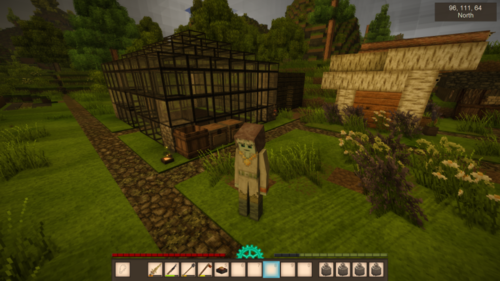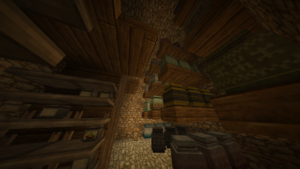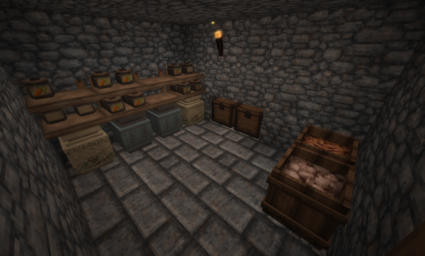Room/es
This page was last verified for Vintage Story version 1.19.5.
Rooms are a type of structure players may create for staying warm and avoiding the consequences of harsh winter, or to use as cellars or greenhouses.
The game checks through each block in a room to determine the sunlight level of each of the blocks inside the room and the coolness level of each of the blocks making up the walls, floor, and ceiling of the room. If it determines there are no open exits it will classify it as an enclosed room.
All valid rooms are enclosed rooms with the exception of open-air cellars for making blue cheese. All rooms additionally have a cooling score and a skylight score. These are largely relevant for two special room types, cellars and greenhouses.
If the player is in a room that has either no holes or a skylight score of less than 50%, including something like a small cave,
- Heat from a heat source extends farther out into the room,
- Wind no longer reduces player body temperature,
- While sleeping, player body temperature will slowly adjust towards normal.
Additionally, but only when players are in a fully enclosed room, the increased hunger rate from harsh winters will be removed.
Creation
Any fully-enclosed space whose interior volume fits within a 14x14x14 bounding box may be counted as a room by the game when all sides of the room are made up of solid blocks with no gaps or holes at all.
Certain blocks have unique conditions for being counted as solid by the game. Leaded glass panes, doors, with the exceptions of crude, sleek, and ruined doors, and trapdoors count as solid blocks, regardless of the position they are in or gaps they leave open.
Slabs are counted as solid on the side that is flush with other blocks but not on any others, however if the flush side faces the outside instead of the inside of the room then the game will count the block that slab is in as part of your room and check that it is within the bounding box.
Faces of Chiseled blocks only need to be "almost solid", meaning that no more than 32 voxels are missing from that face in total, to count as solid. As long as you have at least 50% of the total volume of the block filled in with voxels and the game sees the inward or outward face of the block as solid it will count the block itself as solid.
| Protip: |
Greenhouse
Un invernadero es una estructura destinada a hacer posible la agricultura de cultivos en climas que durante parte del año se vuelven demasiado fríos para que los cultivos pueden seguir creciendo. Si se construye correctamente, las tierras de cultivo, así como los árboles frutales, los arbustos de bayas y las colmenas dentro de la estructura se comportarán como si la temperatura fuera 5°C más cálida que la temperatura exterior actual, y el beneficio de +5°C será visible como una línea adicional en la información de bloques para tierra azada.
Creación
Greenhouses require a skylight score of at least 50%, meaning it is impossible to build one completely covered underground. Greenhouses that are set one block below ground level will still incur the underground farming penalty, if that was turned on during world creation, no matter how much sunlight it receives.
When building a greenhouse, water blocks placed between farmland counts as part of the height of the allowable 14x14x14 area - forgetting this can lead to the game not registering a newly-built greenhouse for being too large. This can be avoided by hiding water source blocks under the outer walls of the greenhouse, as the game will not count the corners as part of the room.
| Protip: |
Skylight Score
Any blocks inside the room that have at least as much sunlight as outside the room will count toward the skylight count. The total skylight score is determined by dividing the skylight count by the total volume of blocks inside the room. Player-created light sources, such as torches and lanterns, have no impact on skylight score. Common blocks used to allow in light include glass blocks and leaded glass panes.
| Protip: |
Cellar
Cellars are used to store any goods that will spoil at a much slower spoil rate compared to non-cellar rooms, or outdoors.
Creation
When detecting a room the game will make extra checks to see if the room is small enough to be a cellar. Normally this is anything within a 7x7x7 cube, but it is possible to build up to 9 blocks wide in a single direction so long as the total volume of all the blocks inside the cellar is no more than 150.
Cellars do not need to be underground to work, however since sunlight levels can affect cellar effectiveness, it may be easier to dig an underground cellar than to create an above-ground one.
| Protip: |
Cooling Score
Any blocks may be used to create a cellar, but different blocks have different insulation values. Blocks in the stone, soil, ceramic, or ore classes are the best insulators, and will each add 1 to the cooling block total. The one exception being farmland which gives 3 to the non-cooling block total, as do trapdoors. Airtight doors add 3 per block of space they occupy when open and 1 per block when closed to the non-cooling block total. The game creates the cooling score by dividing the non-cooling block total by the cooling block total and capping the number at 1, for 100%.
| Protip: |
As a result, the most effective cellars are made of highly insulating blocks (stone, soil, ceramic or brick, ore) and are closed with airtight doors.
Food Preservation
The main use of cellars is for food preservation, however cellars reduce the rate of spoilage for any good stored inside whether it is a food or not. This reduced rate of spoilage stacks with container types, so placing storage vessels and sealed crocks into a cellar can drastically extend the shelf-life of any food inside them.
When calculating how fast food will spoil in a cellar, the game first creates a cellar effectiveness score, which starts at 100%. Up to 40% can be deducted based on the skylight score (that is, the amount of sunlight the cellar receives), and up to 50% can be deducted based on the cellar's cooling score.
The air temperature inside the cellar will never be greater than the air temperature outside. When the effectiveness of the cellar is 100%, the air temperature will cap at 5°C. Otherwise the game will calculate air temperature inside the cellar based on the effectiveness score and skylight score, in addition to how much sunlight is in the container block being affected.
| Protip: |
Cheese Ripening
Cellars can also used to ripen cheese, by lowering its perish rate until it can ripen before it spoils. Cheese can only ripen when placed onto a shelf with a perish rate of 0.5x or lower. Cheddar does not have to be made in a cellar and can be made outside if it is cold enough, while blue cheese must be made in a special kind of open-air cellar with at least one open exit and the shelf must have a sunlight level below 2. This special open-air cellar will not count as an ordinary room, so it will not get the normal bonus for cooling. Blue cheese still needs to be ripened with a perish rate of 0.5x or lower, however, so blue cheese can only be ripened when it is cold enough outside to lower the perish rate to the necessary level.
| Protip: |
| Farming | |
|---|---|
| Wild foods | Berries • Cactus (saguaro) fruit • Mushrooms • Cattail (and papyrus) |
| Grains | Amaranth • Cassava • Flax • Rice • Rye • Spelt • Sunflower |
| Vegetables | Cabbage • Carrot • Onion • Turnip • Parsnip • Peanut • Pumpkin • Soybean |
| Fruits | Fruit trees • Pineapple |
| Other | Fertilizer • Beekeeping • Room |
| Tools | Hoe • Scythe • Fruit press |
| See also | Animal husbandry • Cooking • Food preservation |
| Wiki Navigation | |
|---|---|
| Vintage Story | Guías • Preguntas más frecuentes (FAQ) • Vintage Story Original Soundtrack • Versiones • Controles |
| Mecánicas de juego | Fabricación • Talla Lítica • Alfarería • Herrería • Cocina • Temperatura • Hambre • Minería • Estabilidad temporal • Energía mecánica • Comercio • Agricultura • Ganadería |
| Mundo | Generación del Mundo • Biomas • Clima • Tormentas temporales |
| Objetos | Herramientas • Armas • Armadura • Ropa • Mochilas • Materiales • Comida |
| Bloques | Terreno • Plantas • Decorativo • Iluminación • Functional • Minerales |
| Entidades | Entidades hostiles • Animales • NPCs • Jugadores |
| Miscellaneous | List of client commands • Lista de comandos del servidor • Creative Starter Guide • Bot System • Cómo utilizar Worldedit • Cinematic Camera • Adjustable FPS Video Recording • ServerBlockTicking |



